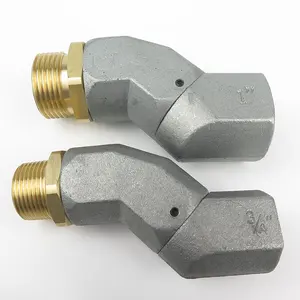

Fuel Dispenser Fuel Hose Swivel 360 Degree Live Swivel Joint




















Swivel joints, the pivotal components in versatile piping systems, stand as the cornerstone for facilitating fluid movement in numerous industrial and residential applications. These rotating joints are engineered to allow continuous 360-degree rotation of connected pipes, thereby minimizing physical stress and preventing potential damage during fluid transfer.
The selection of a swivel joint is critical and varies based on the application. For instance, a PVC swivel joint is often utilized for its smooth internal surface, reducing flow resistance and offering a cost-effective solution for less demanding environments. Conversely, a hydraulic swivel joint is designed to withstand the rigors of hydraulic systems, ensuring durability and leak-free performance under high pressure.
In commercial settings, swivel couplings play a vital role in maintaining the integrity of dynamic piping systems. These components are especially crucial in high-movement areas, where a hose reel swivel joint can prevent hose kinking and wear. Similarly, chiksan swivel joints are renowned for their robustness in oilfield applications, providing reliable service in high-pressure and high-temperature conditions.
The advantages of incorporating swivel joints into piping systems are manifold. A pipe swivel joint not only enhances the system's flexibility but also contributes to the longevity of the pipes and hoses by reducing mechanical stress. In residential plumbing, a locking swivel joint or a lockable swivel joint can be employed to secure the orientation of pipes, preventing accidental rotations that could lead to leaks or damage.
For applications demanding precise control, a rotary swivel joint or an OPW swivel can offer the precision needed for effective fluid management. These specialized swivel joints are designed to maintain a secure connection while providing the freedom of movement essential for complex systems. In high-pressure cleaning equipment, a pressure washer swivel joint is indispensable, ensuring that the washer hose remains flexible and manageable despite the high-pressure output.
Swivel joints are integral to the functionality and efficiency of various piping systems. With a range of materials and types available, these components are tailored to meet the specific needs of different applications, from simple water conveyance to complex industrial processes. The proper selection and integration of a swivel joint can significantly enhance system performance and longevity.